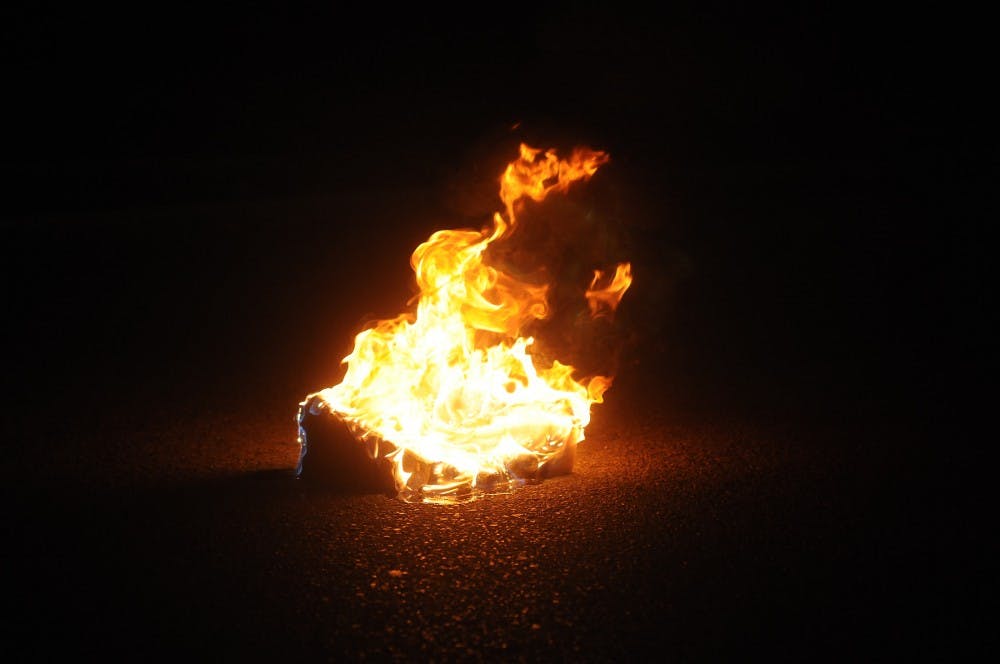East Lansing City Council passed Ordinance No. 1372 by a unanimous vote, effectively amending the section of the City’s disorderly conduct code which prohibited persons to be within 300 feet of an open fire.
The new ordinance effectively rids the previous ordinance’s vagueness, which had been a point of contention for many years since it was passed in 1999 and it also cleaned up the language and added a more thorough explanation of what constitutes unlawful activities when a person is near a fire.
The ordinance now makes it illegal to be “knowingly or intentionally remaining on a public sidewalk or street, private property opened to the public or the unenclosed property of another within 300 feet of a structure fire, vehicle fire or unlawful fire after a fire official determines a public danger exists and orders individuals to vacate the area and a reasonable time period has elapsed which permits individuals to leave the area.”
Lacking in the previous version were orders from police to leave the area and allowing for time for persons to leave the area.
The ordinance goes on to add “no person shall remain on a public sidewalk, public street, private property open to the public or unenclosed private property of another between a fire truck parked adjacent to a structure fire, vehicle fire or unlawful fire that fire officials are seeking to contain while knowingly hindering, obstructing or interfering with fire officials discharging their duties after being ordered to vacate the area.”
This cleans up what is considered unlawful activity as restricting fire officials to put out the fire is clearly added to the ordinance as illegal.
Furthermore the new ordinance added provisions for people and actions exempt from the ordinance including “persons attempting to put out or contain the fire prior to the arrival of fire fighting personnel”, “persons remaining or traveling directly to or from a structure out of necessity”, “persons to whom any fire or police official has given express permission to remain unless that permission is revoked by the on-site fire incident commander or on-site supervisor of the police department”,“person awaiting arrival of public safety personnel to warn others of the danger or provide information about the fire, structures involved, or information that could be useful to public safety personnel.”
The prior version of the code that made it illegal for a person to be within 300 feet of an open fire was put in place following the infamous 1999 riot that engulfed not only MSU but the city as well.
The legality of the prior ordinance came under fire after a case was brought before Judge Andrea Larkin involving two MSU students who were arrested for being within 300 feet of a fire that occurred after MSU football’s victory over the University of Michigan.
Larkin struck down the ordinance the girls were arrested under stating the ordinance was unconstitutional because it was vague and punished inherently innocent conduct.
“The court can envision a myriad of ways that innocent conduct could be criminalized,” Larking wrote in her ruling.
Following Larkin’s ruling, Mayor Mark Meadows told The State News he didn’t agree with Larkin’s ruling and an appeal of the ruling or amendment to the original ordinance would be forthcoming. He backtracked on Tuesday saying at the meeting after years having never really looked back on the ordinance, he re-read it and determine he too was in agreement with Larkin’s ruling.
“It struck me that it so clearly was unconstitutional, that I’m embarrassed that I voted for it to begin with other than we were reacting to circumstances at the time and with a rush that we were trying to deal with issues that frankly I don’t think we had seen in the city ever before” Meadows said at the meeting.
Patrick Rose, who iterated his years of legal experience at various levels of the courts including federal, spoke at the public hearing about the ordinance. He also cited years of experience in defending people charged under the ordinance and advised council substitute the ordinance he authored.
He re-wrote Council’s ordinance after discussing with a plethora of sources including the ACLU, other attorneys and East Lansing citizens. His ordinance put an emphasis on bringing the ordinance into constitutionality by offering guidance for a judge to find wrongdoing by defining the crime and making sure police were required to give notice to leave the area instead of just handing out tickets.
Meadows applauded Rose’s efforts and the East Lansing community for coming together to create the ordinance.
Support student media!
Please consider donating to The State News and help fund the future of journalism.
Discussion
Share and discuss “E.L. fire ordinance amended, granting time for those near fires to leave” on social media.

